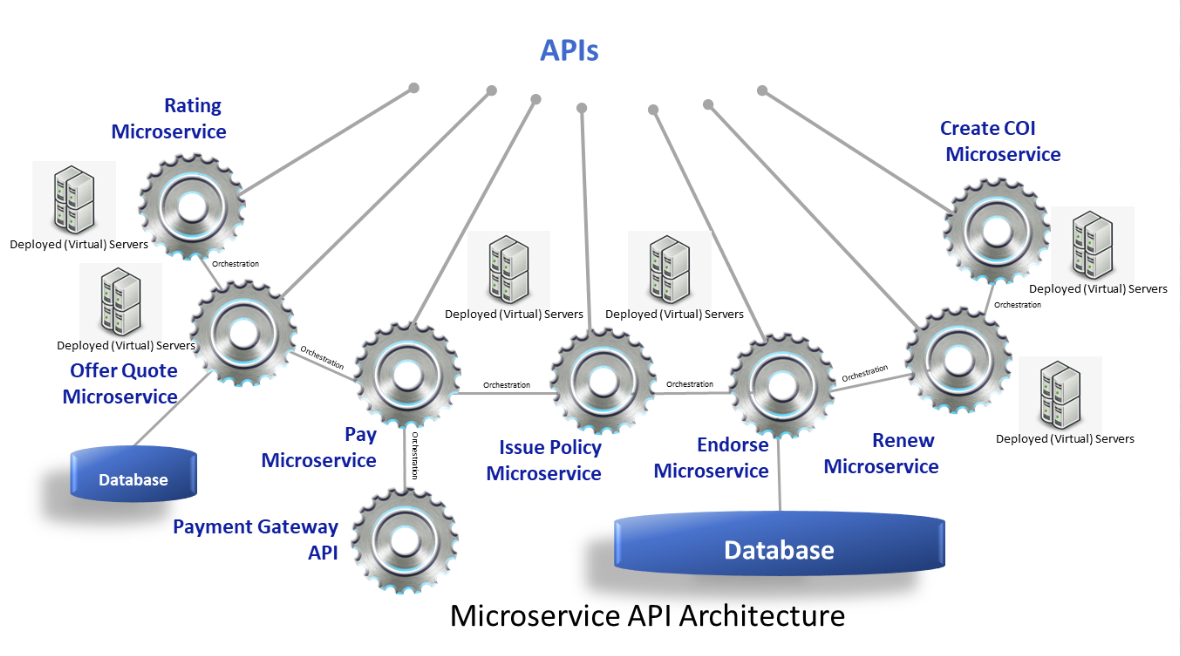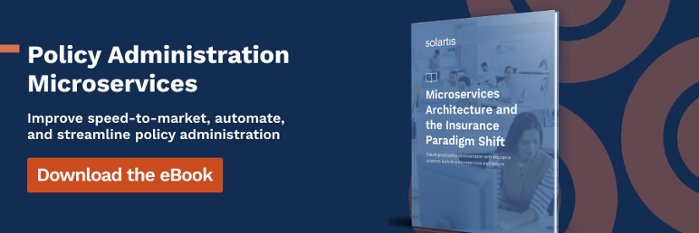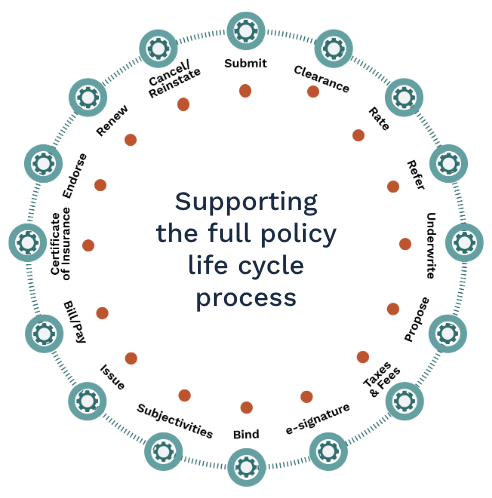While "microservices" and "APIs" are often used interchangeably, they actually refer to two very different things.
What are Microservices?
Microservices are discrete, free-standing, independent services. They can be designed, developed, versioned, tested, managed, and deployed autonomously without affecting the entire system. Microservices can be integrated with each other and with other systems without any dependency constraints, and they can be orchestrated with other microservices to create “macro” services.
Because they run independently, individual microservices can be replaced without affecting the entire system. This autonomous operation also means that microservices significantly reduce the chance that a single point of failure will bring down the entire system.
An example of a microservice in insurance policy administration is document generation. Document generation microservices merge one or more form templates with policy data to create a single, unique insurance document. Policy data is maintained and managed outside the document generation microservice and supplied as an input when the document is created. Similarly, form templates will be managed, versioned, and maintained outside the document generation microservice.
In a traditional monolithic policy administration system, document generation is tied to other services in a tight bundle: rating, transaction, utility, validation, etc. Insurance microservices break that bundle down so that each service operates independently.
What are APIs?
Application Programming Interfaces, or APIs, on the other hand, are translators or extendable hooks - programmable interfaces between two systems rather than the actual system itself. They act as hooks in a software system, allowing one application to talk to another to exchange information or expose functionality. APIs also provide an interface for software systems to extend their functionality to other applications.
APIs integrate and invoke an underlying functionality embedded within the software system or service. Microservices are also exposed using APIs. In the document generation microservice example above, an API would pull policy data from the policy database and format it for insertion into the proper category on the document that is being generated.

Illustration: Example Policy Administration Microservices connected via APIs
Why consider microservices?
Microservices have a range of benefits over their traditional, monolithic predecessors. These include:
- Independent: Microservices are not bundled together, so they operate independently of each other and of the larger systems at work.
- Feature-focused: Solves for a single function.
- Agile: Changes can be implemented to one service without needing a total system rebuild.
- Variety of Code Base: Microservices operate on their own code base, so each can run on the best for that service; rather than being restricted to the code base of the monolithic system.
- Pick & Choose: The business can select best-of-breed services to be used in the system without being restricted to those that work within the monolithic system.
- Plug & Play: Microservices are more easily replaced than monolithic software since the dependency on other components is limited.
- Performance: Microservices perform better - faster and more efficiently than bundled services.
- Maintainability: Each service can be independently maintained without testing for interdependencies across the system.
- Scalability: Microservices are deployed in a set of servers in a clustered manner, which allows increasing and decreasing servers quickly to meet changes in demand.
- Availability: Microservices are highly available and reduce the chance of a single point of failure.
What can APIs do for you?
APIs expose software functionality through a programmable interface. They allow the software to connect to other software systems, either those available internally or outside third-party applications. This supports innovation, as your business can improve the variety of features and services offered.
For example, instead of requiring a customer to physically sign a paper copy of a form, an insurer could use an API that integrates their document generation system with a third-party partner, like DocuSign. DocuSign is a digital signature software – integrated with a document generation service – it would allow a customer to sign off on a policy document remotely.
The Benefits of Insurance APIs
- Eliminate data entry
- Enable remote access
- Improve customer journey
- Streamline workflows
- Access new revenue streams
Learn more: Check out the Solartis API ecosystem
APIs are not unique to microservices - monolithic software systems may also use APIs to connect to outside services. Microservices and APIs are valuable and relevant to insurance companies interested in streamlining, modernizing, and improving their products and services.
However, these terms should not be used interchangeably. Microservices are the unbundled actions undertaken to achieve a specific end: ratings, transactions, document generation, taxes & fees, Certificate of Insurance, Auto ID, etc.
APIs are the translators and hooks that allow software systems to speak to certain functionalities in other software systems, networked systems, and third-party applications. Together, policy administration microservices and insurance APIs improve flexibility, agility, and innovation across the insurance industry.
"They are fast, simple, and cost-effective. Their team is an extremely reasonable group of people who care, really care, about your success. Every launch has some bumps - they worked above and beyond to make sure those bumps didn't disrupt our launch or our ability to write new business. Without Solartis, I wouldn't be projecting a 30% increase in topline growth."
said Cameron Linder, CEO, Western Bowling Proprietors Insurance (WBPI), Rednil Insurance Brokers, Inc.





